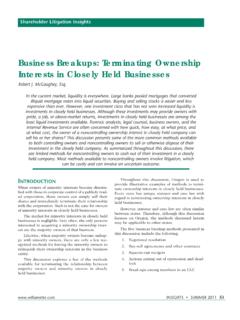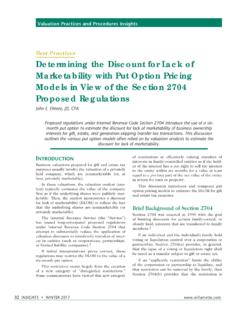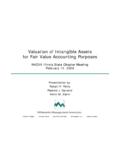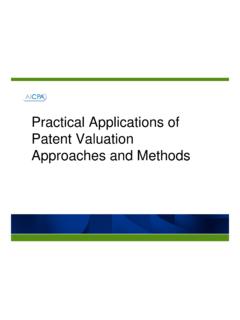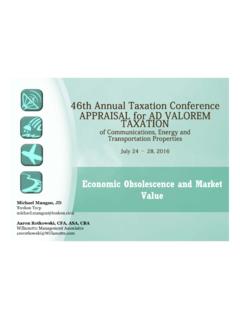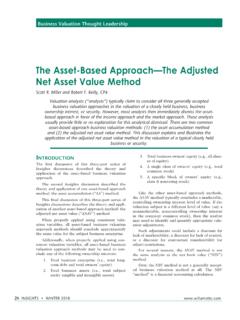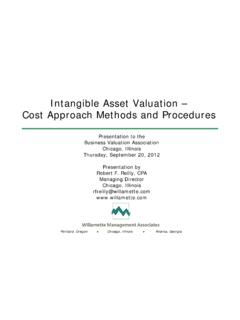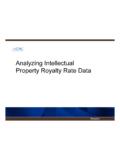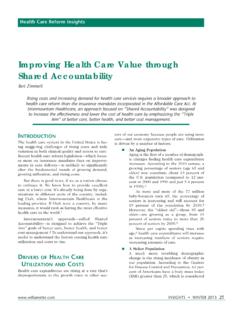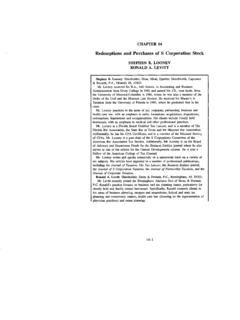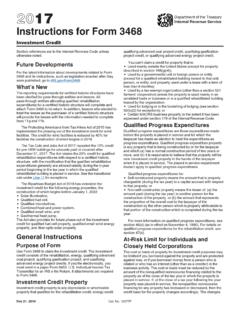Transcription of Insights Winter 2010 52 - Willamette Management Associates
1 Insights Winter 2010 . 52. Gift and Estate Tax Valuation Insights The Combined Discount Robert P. Schweihs For a variety of reasons, the value of an ownership interest in a closely - held business enterprise may be subject to the application of a valuation discount. Valuation analysts often apply a combined discount to reflect one total value decrement related to both of two common valuation adjustments: (1) the discount for lack of ownership control (2) and the discount for lack of marketability. This discussion describes the theory and the rationale for the combined discount. And, this discussion points to recent empirical data that suggest that the combined discount may be larger than previously indicated. Introduction 1.
2 Blockage, related to the size of the subject minority ownership interest;. The value of a fractional interest investment in a business 2. restricted stock, related to SEC regulations or employ- enterprise is not necessarily equal to a pro rata percentage ment agreement provisions; and of the overall value of the entire enterprise. A fractional interest in a business enterprise that has 3. contractual restrictions, related to shareholder, partner- little or no voice in company affairs, by definition, suf- ship, or other buy-sell agreements. fers from a lack of ownership control. Such a fractional ownership interest is sometimes referred to as a minority Some minority ownership interests are subject to non- interest. Unless there is a statutory, contractual, or other systematic risk-related valuation discounts, such as: reason that prevents it, the value of a minority interest in a business enterprise is usually less than the pro rata per- 1.
3 Key person dependence, centage of the overall value of that business enterprise. The two valuation adjustments that are most common 2. key customer dependence, to the valuation of a minority interest in a closely held 3. key product dependence, business enterprise are (1) the discount for lack of con- 4. obsolescence of technology or facilities, and trol (DLOC) and (2) the discount for lack of marketability 5. built-in capital gains. (DLOM). In some circumstances, valuation analysts may consider these two discounts collectively and refer to this aggregate valuation adjustment as a combined discount. This discussion is focused on the DLOC and the DLOM. Important to the discussion of valuation discounts is the that are applied to minority interests in a closely held notion that discounts have no meaning until the base of business enterprise and that do not suffer from other trans- value to which they are applied has been clearly defined.
4 Ferability restrictions or nonsystematic risk. In these situ- For example, other than lack of control and lack of ations, valuation analysts will sometimes apply one com- marketability, the subject ownership interest may have bined discount to reflect both the DLOC and the DLOM. characteristics that justify the application of other miscel- In other words, after estimating the marketable, control- laneous valuation discounts that are separate from DLOC ling ownership interest value of a company, individual dis- and DLOM. These other miscellaneous discounts can be counts for lack of control and for lack of marketability or grouped into two categories: an aggregate discount representing a combination of these two investment factors may be applied by the valuation 1.
5 Discounts related to transferability restrictions analyst in order to estimate the value of the subject minor- 2. discounts related to nonsystematic risk ity equity interest. Most of the evidence on which valuation analysts rely to estimate a DLOC and a DLOM is based, at least in part, Some minority ownership interests are subject to trans- on an analysis of transactions in publicly traded common ferability restrictions, such as: equity securities. Winter 2010 Insights . 53. Valuation analysts may also consider data on privately 3. set policy and change the course of business negotiated transactions of limited partnership interests. 4. acquire or liquidate assets The price discount derived by comparing the transaction 5.
6 Select people with whom to do business and award con- price with the partnership's net asset value is typically tracts viewed as a reflection of the limited partnership interest's lack of both control and marketability. 6. make acquisitions Some valuation analysts believe that, in recent years, 7. liquidate, dissolve, sell out, or recapitalize the com- the size of the DLOC and DLOM that are applicable to non- pany marketable, noncontrolling interests in closely held busi- 8. sell or acquire treasury shares ness enterprises has decreased. This discussion presents: 9. register the company's stock for a public offering (1) a brief history of studies that reveal the size of these 10. declare and pay dividends valuation discounts and (2) some recent data that reveal that the size of these valuation discounts may not have 11.
7 Change the articles of incorporation and bylaws decreased (as some valuation analysts have suggested). This list illustrates that the owner of a controlling inter- est in an enterprise enjoys valuable rights that the owner Theory and Rationale of a minority interest does not. However, some factors may All other factors being equal, an investment is more valu- limit a majority owner's right to exercise many of the pre- able if it is easily marketable and, conversely, less valuable rogatives normally associated with ownership control, thus if it is not easily marketable. Simply stated, investors prefer limiting the value accruing to the control position. liquidity to lack of liquidity. On the other hand, a minority interest investment It is difficult to liquidate a controlling ownership inter- may not be totally bereft of control factors.
8 For example, a est in most closely held businesses. In most situations, it is minority interest investor may be in a position to cast cru- even more difficult to liquidate a noncontrolling ownership cial swing votes and, in some measure, influence important interest in a closely held company. business policies. An investment in the equity of a closely held company A willing buyer contemplating the purchase of a non- is relatively illiquid compared to other investments, and controlling ownership interest from a willing seller would particularly compared to publicly traded securities. consider these disadvantages arising from a lack of control. In order to understand the rationale behind applying Therefore, regardless of the controlling ownership interest a valuation discount to a privately owned partnership or value of a company, one would not expect a willing buyer a closely held company equity value indication, valuation to purchase a noncontrolling ownership interest except at analysts should consider the basis on which the unadjusted a price discount from its pro rata share of the controlling value indication has been estimated.
9 Ownership interest value of a company. A controlling ownership interest in a closely held com- pany is often estimated from the perspective of an investor who can directly buy or sell the underlying assets. Discount for Lack of Marketability An ownership interest in a closely held company is typi- The DLOM measures the difference in the expected price cally subject to liquidity limitations. These limitations are of (1) a liquid asset (that is, the benchmark price measure). not reflected in the market value of the operating assets and (2) an otherwise comparable illiquid asset (that is, the owned by the company. valuation subject). The concept of investment marketability relates to the liquidity of an investment that is, how quickly and Discount for Lack of Control certainly the investment can be converted into cash at Control rights, if any, are an important variable affecting the owner's discretion.
10 Investors value liquidity. Rational the value of a closely held company. The price premium investors will pay a price premium for liquidity. Conversely, for control or the price discount associated with a lack of rational investors will demand a price discount for lack of control depends on the equity holder's ability to exercise liquidity. any or all of a variety of rights typically associated with The security of a closely held company is not as liquid control. as the otherwise comparable security of a publicly traded By definition, the holder of a minority interest lacks company. That is, a closely held company security does ownership control. The following list provides examples of not have the same degree of marketability as the otherwise some of the common prerogatives of ownership control: comparable publicly traded security.
